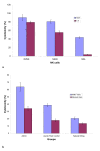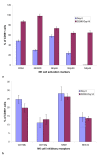Anti-West Nile virus activity of in vitro expanded human primary natural killer cells
- PMID: 20089143
- PMCID: PMC2822749
- DOI: 10.1186/1471-2172-11-3
Anti-West Nile virus activity of in vitro expanded human primary natural killer cells
Abstract
Background: Natural Killer (NK) cells are a crucial component of the host innate immune system with anti-viral and anti-cancer properties. However, the role of NK cells in West Nile virus (WNV) infection is controversial, with reported effects ranging from active suppression of virus to no effect at all. It was previously shown that K562-mb15-41BBL (K562D2) cells, which express IL-15 and 4-1BBL on the K562 cell surface, were able to expand and activate human primary NK cells of normal peripheral blood mononuclear cells (PBMC). The expanded NK cells were tested for their ability to inhibit WNV infection in vitro.
Results: Co-culture of PBMC with irradiated K562D2 cells expanded the NK cell number by 2-3 logs in 2-3 weeks, with more than 90% purity; upregulated NK cell surface activation receptors; downregulated inhibitory receptors; and boosted interferon gamma (IFN-gamma) production by approximately 33 fold. The expanded NK (D2NK) cell has strong natural killing activity against both K562 and Vero cells, and killed the WNV infected Vero cells through antibody-dependent cellular cytotoxicity (ADCC). The D2NK cell culture supernatants inhibited both WNV replication and WNV induced cytopathic effect (CPE) in Vero cells when added before or after infection. Anti-IFN-gamma neutralizing antibody blocked the NK supernatant-mediated anti-WNV effect, demonstrating a noncytolytic activity mediated through IFN-gamma.
Conclusions: Co-culture of PBMC with K562D2 stimulatory cells is an efficient technique to prepare large quantities of pure and active NK cells, and these expanded NK cells inhibited WNV infection of Vero cells through both cytolytic and noncytolytic activities, which may imply a potential role of NK cells in combating WNV infection.
Figures







Similar articles
-
The natural killer cell response to West Nile virus in young and old individuals with or without a prior history of infection.PLoS One. 2017 Feb 24;12(2):e0172625. doi: 10.1371/journal.pone.0172625. eCollection 2017. PLoS One. 2017. PMID: 28235099 Free PMC article.
-
West Nile virus-infected human dendritic cells fail to fully activate invariant natural killer T cells.Clin Exp Immunol. 2016 Nov;186(2):214-226. doi: 10.1111/cei.12850. Epub 2016 Sep 22. Clin Exp Immunol. 2016. PMID: 27513522 Free PMC article.
-
A systems biology approach reveals that tissue tropism to West Nile virus is regulated by antiviral genes and innate immune cellular processes.PLoS Pathog. 2013 Feb;9(2):e1003168. doi: 10.1371/journal.ppat.1003168. Epub 2013 Feb 7. PLoS Pathog. 2013. PMID: 23544010 Free PMC article.
-
Role of natural killer and Gamma-delta T cells in West Nile virus infection.Viruses. 2013 Sep 20;5(9):2298-310. doi: 10.3390/v5092298. Viruses. 2013. PMID: 24061543 Free PMC article. Review.
-
The innate immune playbook for restricting West Nile virus infection.Viruses. 2013 Oct 30;5(11):2643-58. doi: 10.3390/v5112643. Viruses. 2013. PMID: 24178712 Free PMC article. Review.
Cited by
-
Systems analysis of West Nile virus infection.Curr Opin Virol. 2014 Jun;6:70-5. doi: 10.1016/j.coviro.2014.04.010. Epub 2014 May 20. Curr Opin Virol. 2014. PMID: 24851811 Free PMC article. Review.
-
Iodine-125 seed implantation and allogenic natural killer cell immunotherapy for hepatocellular carcinoma after liver transplantation: a case report.Onco Targets Ther. 2018 Oct 25;11:7345-7352. doi: 10.2147/OTT.S166962. eCollection 2018. Onco Targets Ther. 2018. PMID: 30498359 Free PMC article.
-
Influenza A Virus Antibodies with Antibody-Dependent Cellular Cytotoxicity Function.Viruses. 2020 Mar 1;12(3):276. doi: 10.3390/v12030276. Viruses. 2020. PMID: 32121563 Free PMC article. Review.
-
Effect of NK cell immunotherapy on immune function in patients with hepatic carcinoma: A preliminary clinical study.Cancer Biol Ther. 2017 May 4;18(5):323-330. doi: 10.1080/15384047.2017.1310346. Epub 2017 Mar 29. Cancer Biol Ther. 2017. PMID: 28353401 Free PMC article.
-
In response.Am J Trop Med Hyg. 2013 Dec;89(6):1226-1227. doi: 10.4269/ajtmh.13-0443b. Am J Trop Med Hyg. 2013. PMID: 24306032 Free PMC article. No abstract available.
References
-
- Vargin VV, Semenov BF. Changes of natural killer cell activity in different mouse lines by acute and asymptomatic flavivirus infections. Acta Virol. 1986;30:303–8. - PubMed
-
- Liu Y, King N, Kesson A, Blanden RV, Mullbacher A. Flavivirus infection up-regulates the expression of class I and class II major histocompatibility antigens on and enhances T cell recognition of astrocytes in vitro. J Neuroimmunol. 1989;21:157–68. doi: 10.1016/0165-5728(89)90171-9. - DOI - PMC - PubMed
MeSH terms
Substances
LinkOut - more resources
Full Text Sources
Other Literature Sources
Medical
Research Materials
Miscellaneous

